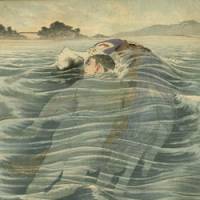Yayoi Museum Closes on March 28
Next door to the Yumeji Takehisa Museum, and serving as its companion in terms of period and spirit, is the Yayoi Museum. Its third floor houses a permanent exhibition of works by the little-known Taisho (1912-26) and Showa (1926-89) era illustrator Kasho Takabatake, but the lower floors feature special exhibitions, such as the current "130th Anniversary Exhibition of Hirezaki Eiho," which includes 350 artworks and items associated with the artist whose career covered three eras, from Meiji (1868-1912) to Showa.
Born in 1880, Eiho studied under the ukiyo-e artist Toshihide Migita, but later moved into book, magazine and newspaper illustration, where he was something of a pioneer. The end of the Meiji era saw an upsurge in the printed word, with a massive output of magazines and novels, many aimed at a new working-class female audience. To help ease the transition to literacy, these were often lavishly illustrated with kuchi-e (literally, "mouth pictures"), colorful foldout illustrations hand-printed in the tradition of ukiyo-e style.
Eiho became famous for his sketches of sumo wrestlers in action that appeared in the Asahi Shimbun newspaper, but far more satisfying are his elaborate kuchi-e, such as the one produced for the 1905 publication of "Zoku Furyusen" ("The Line of Elegance"), a novel by Kyoka Izumi. This shows the artist's skillful use of shading, here employed to create the movement and transparency of waves. After his death in 1968, he was largely forgotten, but recently there have been moves to reappraise his work.

















With your current subscription plan you can comment on stories. However, before writing your first comment, please create a display name in the Profile section of your subscriber account page.